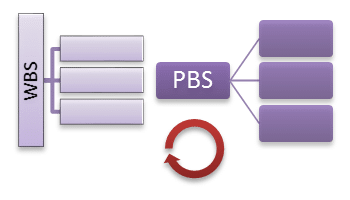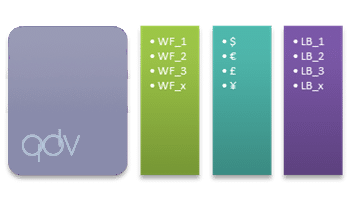Organization of Documents
QDV embeds in a single file all documents used in an estimate whether for costing or pricing. Additionally, all documents are interactively linked.
Embedded in single file


Embeds in a single file all documents used in an estimate.
Templates


Easy parameterization and use of templates to match your specific needs.
Templates
Easy parameterization and use of templates to match your specific needs. Templates can be easily built: Any estimate can become as a template.
Work Breakdown Structure with Detailed Leaves
QDV provides a well-organized estimate beginning with a Work Breakdown Structure (WBS) based upon a functional, geographical or business data set of your project. The WBS appears as a tree where each leaf contains a high level of detail (called a Minute). A leaf can also be fed by an embedded Excel Workbook. Columns in the WBS and columns being in the minutes (the tree leaves) are fully configurable.
WBS and other structures


Simultaneously structured according to a Work Breakdown Structure (WBS), a Product Breakdown Structure (PBS) or under other guidelines.
Tendering documents


Tendering documents are the documents your customer asks you to complete with pertinent project data.
Dynamically fills-in any type of tendering document
Tendering documents under QDV are the documents your customer asks you to complete with pertinent project data. QDV imports any type of Excel Workbook, even those with protected sheets and integrates data from your estimate. This can be accomplished even if the shape of these documents is fully different from your WBS. Additionally, if new tendering documents are provided by the end-customer during the estimate process, you can import them and map them without losing the links which have already been estimated.
Overhead Workbook
The overhead workbook is an embedded Excel workbook and one is created for each estimate. Some sheets of this workbook are dynamically populated by QDV and can be seen as customizable pivot tables, allowing virtually any data to be collected from the estimate.
The workbook also contains custom sheets which are intended for reporting or for use with pricing calculation using data normally provided from sheets created through QDV.
Results of calculations from these custom sheets, including selling factors, risk factors, rates, etc. are returned back to QDV estimates which provide final pricing prices for each row which composes the estimate: you can provide any breakdown of the estimate in selling prices, regardless of the complexity in the calculation used to determine final pricing.
Overhead Workbook


Organizational Breakdown Structure (OBS) with tables of workforce rates, kinds of materials, currency exchange rates, factors, customized sheets of sales, and more.
Planner
Estimates can feed into a Gantt chart leading to a dynamic cash-flow. Resources can be allocated from the diagram that helps you calculate real costs after considering the availability of resources.
Cash flow gains or losses can be dynamically injected in the sheets of sales to increase or decrease the margin.
Planner


Gantt diagram leading to dynamic cash-flow.
